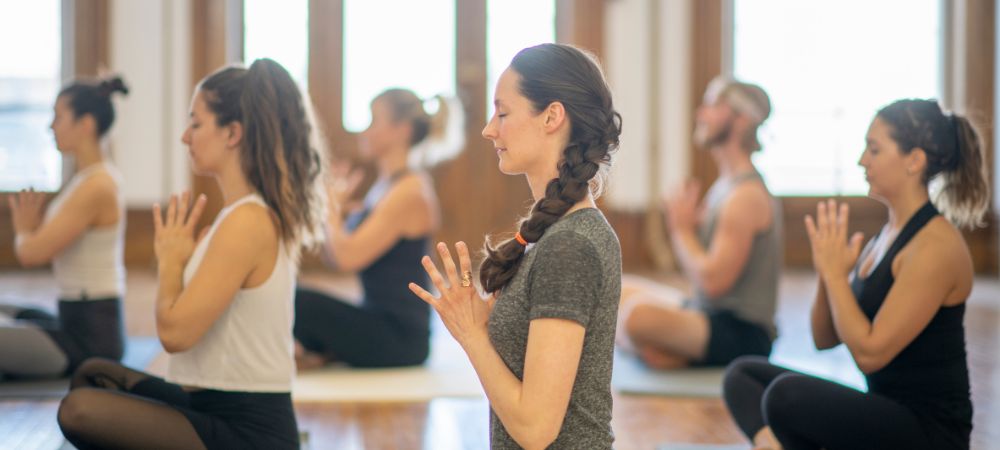Bhakti yoga is a form of yoga that emphasizes devotion, love, and surrender to a higher power. One of the key components of Bhakti yoga is the use of mantras. Mantras are sacred sounds or phrases that are repeated as a form of meditation. In this blog, we’ll delve into the role of mantra in Bhakti yoga and how it can help you connect to the divine.
What is a Mantra?
A mantra is a word, phrase, or sound that is repeated to help focus the mind and promote inner peace and ultimately connect to the divine. Mantras are used in many spiritual traditions and have been used for thousands of years as a tool for meditation and spiritual growth. The most popular mantra used by those who follow the Hare Krishna faith is the Maha mantra.
The Role of Mantra in Bhakti Yoga
In Bhakti yoga, mantras are used as a tool to cultivate inner devotion and connect to the divine. The repetition of a mantra can help quiet the mind and bring the practitioner into a state of deep concentration. This can be especially helpful for those who find it difficult to control the mind and meditate.
By repeating a mantra, the practitioner is able to direct their attention towards the divine and away from overwhelming thoughts and distractions. This can lead to a sense of inner peace, calm and connection to the higher self. The repetition of a mantra can also help the practitioner cultivate feelings of love and devotion, which are principal aspects of Bhakti yoga.
Choosing a Mantra
There are many mantras that can be used in Bhakti yoga which have been outlined in the sacred yoga texts. Some common Bhakti yoga mantras include “Om Namo Bhagavate Vasudevaya (I offer my respects to the Divine ), “Hare Krishna” (Glory to Krishna), and “Om ” (Peace).
When choosing a mantra to chant, it is important to consider your intention and what you hope to achieve through its repetition. You may choose a mantra that is associated with a specific deity, or one that represents a particular aspect of the divine that you wish to connect with.
Using Mantra in Your Practice
Once you have chosen a mantra, you can begin incorporating it into your Bhakti yoga practice. Mantras can be repeated silently or out loud and can be chanted for a specific amount of time or for as long as you wish.
It can be helpful to choose a quiet and comfortable place to repeat your mantra, and to close your eyes and focus on the sound vibration, using the breath as a supportive tool to silence the mind. As you repeat the mantra, allow any thoughts or distractions to drift away and focus your attention on the sound of the mantra.
Incorporating mantra into your Bhakti yoga practice can be a powerful tool for spiritual growth and connection to the divine. By repeating a mantra, you can cultivate devotion, love, and inner peace, and simultaneously deepen your connection to your higher self and the divine.
 Alternatives to Using a Mantra
Alternatives to Using a Mantra
In Bhakti Yoga, if for some reason you are not comfortable with using a mantra, you can use other tools to cultivate devotion and connect to the divine. Some alternative tools include:
- Chanting of holy scriptures: Chanting verses from religious scriptures such as the Bhagavad Gita, Ramayana, or the Srimad Bhagavatam can help cultivate devotion and connect to the divine.
- Singing devotional songs: Singing devotional songs in the form of bhajans or kirtans can be an effective way to connect to the divine and evoke feelings of love and devotion.
- Visualization: Visualizing a deity or an aspect of the divine can help cultivate feelings of devotion and bring the practitioner closer to a higher power.
- Prayer: Regular prayer can be a powerful tool for expressing devotion and connecting to a higher power.
- Service: Engaging in selfless service, such as volunteering or helping others, can also be a way to cultivate devotion and connect to a higher power.
Each individual is unique, and the tool that works best for one person may not work for another.
 What to Use Instead of a Mantra
What to Use Instead of a Mantra
Bhakti Yoga is a path of devotion and surrender to a higher divine power that doesn’t entail you to be tied to a specific religion. If you are not religious, you can still practice Bhakti Yoga and connect to a higher power or any aspect of the philosophy and lifestyle that resonates with you. Here are some suggestions:
- Nature: You can cultivate devotion towards nature and connect to the beauty and wonder of the natural world.
- Humanity: You can practice Bhakti Yoga towards humanity and cultivate feelings of love and compassion towards others.
- Personal Values: You can practice Bhakti Yoga towards your personal values and beliefs, such as kindness, honesty, or justice.
- Inner Self: You can practice Bhakti Yoga towards your own inner self and cultivate feelings of love and compassion towards yourself.
In each of these examples, you can use tools such as visualisation, meditation, or service to cultivate feelings of devotion and connect to the object of your devotion. The key is to find something that resonates with you and that you feel a strong connection to. Remember, Bhakti Yoga is about surrendering to the divine power, which is greater than ourselves and cultivating love and devotion, regardless of what that something is.
Practice Using Mantra in Bhakti Yoga
The use of mantra in Bhakti yoga is a pivotal aspect of the devotional path. By using a mantra, or a mantra alternative, that resonates with you and incorporating it into your practice, you can cultivate feelings of love and devotion, and deepen your connection to the divine.
To learn more about Bhakti yoga, check out some of our other resources for Bhakti yoga beginners:
- The Four Principles to Beginning Bhakti Yoga
- 3 Benefits of Learning Bhakti Yoga for Beginners
- Bhakti Yoga For Beginners
- Your Guide To Our Free Weekend ‘Love Feasts’
If you want to practice Bhakti Yoga with like minded locals, come along to our weekly Sunday feast! Our Sunday feasts offer free food, great company, and free Bhakti Yoga sessions for everyone at all skill levels.




